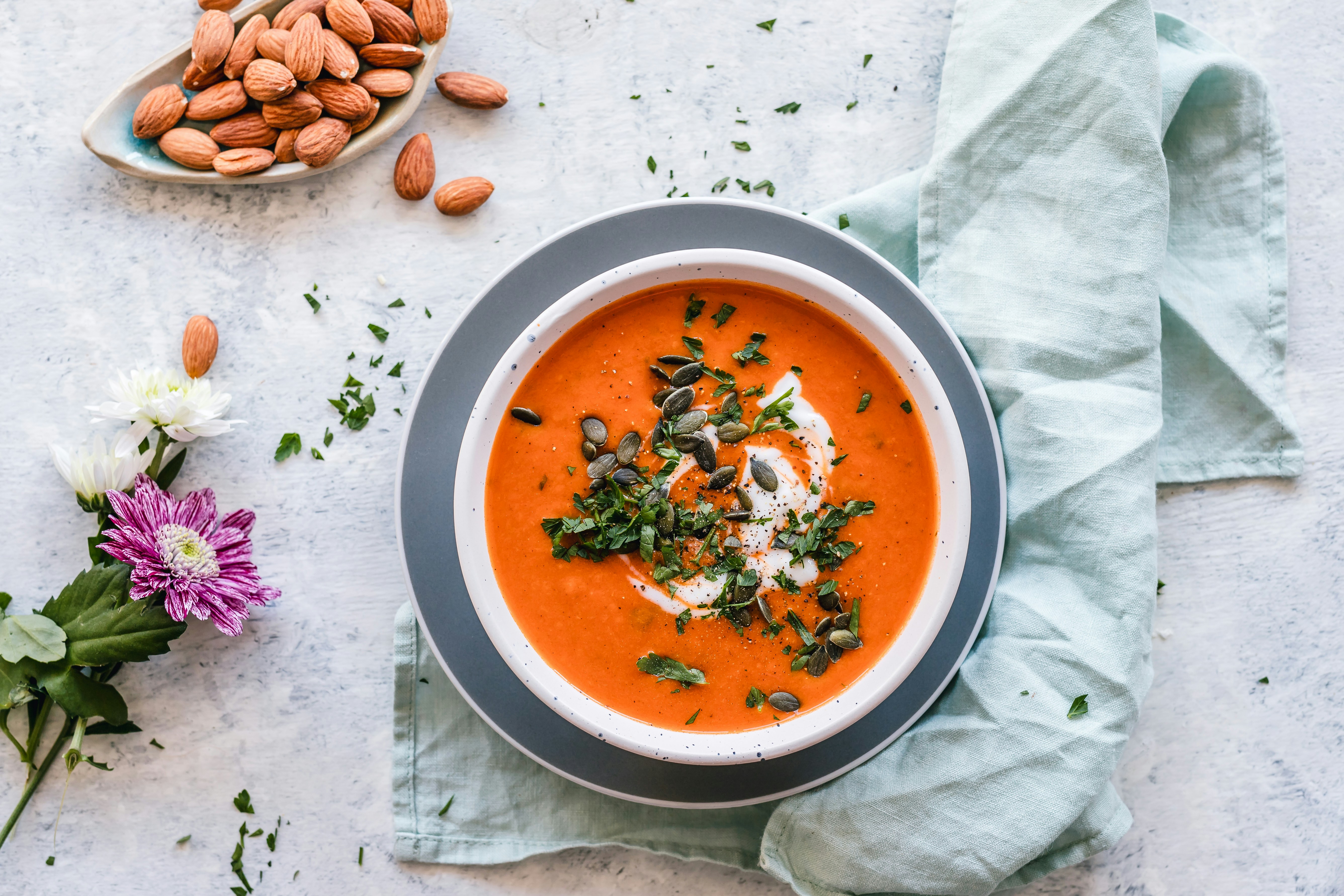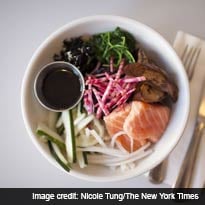The rice bowl has come a long way. Once relegated to health food restaurants and natural food shops, it was a humble, healthful, often vegetarian one-dish meal reminiscent of Japanese donburi and Korean bibimbap, rice bowls topped with meat or fish, vegetables and pickles.Now, you're just as likely to run into a grain bowl, made with the likes of quinoa, farro or freekeh, at the trendiest restaurants as you are at the cafe adjacent to your yoga studio.
Case in point: At Dimes, a new restaurant in Chinatown, you will find a barley bowl topped with pickled salmon and cabbage slaw. At Sqirl in Los Angeles, heirloom brown rice is mixed with cumin and Swiss chard and topped with crisp chorizo. At El Rey Coffee Bar and Luncheonette on the Lower East Side, grits cooked in cashew milk are topped with slow-roasted pork and pickled onions.For evidence that the bowl has gone mainstream, look no further than Chipotle, whose burrito bowl is the biggest selling item on the menu. Yet you rarely hear people talking about grain bowls as easy, healthful, never-dull dinners to whip up at home. But they are exactly that.
They are also visually inviting, with grains, vegetables, protein and well-chosen condiments together in one vessel and arranged into a vibrant, colorful tableau.
Bowls are excellent vehicles for leftovers, no matter how motley. They can accommodate the ever-widening variety of available whole grains (quinoa, kamut, farro, freekeh, wheat berries, barley and grits) that we are all supposed to be working into our diet. And they are ideal for picky eaters in the house, who can build it to suit their own tastes while ensuring that none of the toppings touch.Gerardo Gonzalez, the chef at El Rey, calls a bowl the perfect dish, one in constant movement. "Eating your way around a bowl is a little like tai chi," he said. "The perfect bite doesn't mean you have all the components together on the spoon, it's about getting the balance of acid, sweet, salty. Every bite is a surprise, a little different from the one before it."
When assembling a grain bowl at home, Jessica Koslow, the chef and owner of Sqirl, advises embracing variety."We change our bowls seasonally, varying the recipes to reflect different ingredients at their prime," she said. While the type of grain matters, the real artistry of the bowl is in the combination of toppings. You could spoon almost anything over your grains and call the result a bowl (and some do). But the best bowls have a balanced combination of flavors and textures, and of vegetables, proteins, sauces and garnishes. Ideally, choose a grain that complements the other elements, pairing delicate ingredients (simple steamed vegetables or fish, for example) with milder grains (white rice, grits, barley). But pretty much any grain will work with nearly anything you pile onto it.As for vegetables, anything goes, but greenery is iconic, be it raw, steamed, roasted or sautéed. At Scratchbread in the Bedford-Stuyvesant neighborhood of Brooklyn, my bowl (served in a paper cup) had grits on the bottom, with raw kale, chunks of crisp bacon, a soft-cooked egg and jalapeño sauce layered on top. I especially like the purity and softness of steamed greens - kale, mustard, chard, collards - against the nubby grains. Feel free to use leftover vegetables on top: Those florets of sautéed cauliflower, cubes of baked beets or silky slivers of roasted red peppers can have no better home.Now you need a protein. Think of small amounts of braised or roasted meats or fish, whether left over or freshly cooked. Vegetarians can go for tofu, tempeh, seitan or beans. And anyone can add a soft-cooked egg, preferably one with a runny yolk to coat the other ingredients like an instant sauce.You should also have a sauce on the side for everyone to mix in to taste. Use ingredients that mesh with the flavors of the bowl. Combine soy sauce, sesame oil, ginger and rice vinegar or lime juice for Asian-inspired combinations. Pesto goes nicely with roasted red peppers, eggplant or anything else vaguely Mediterranean. Bottled hot sauce provides spice to the fire-toothed. And a basic vinaigrette will get along with practically anything else.Once you have the bowl assembled - grains, vegetables, protein and sauce - it's time to think about garnishes, which add character and depth. Something pickled or pungent (kimchee, preserved lemon, pickled peppers, a dash of fish sauce) keeps things interesting, and something crunchy (sesame seeds, nuts, toasted seaweed) diversifies the textures. Or combine these if you like: crunchy pickled carrots or radish, for example. Mix and match. Then mix and match again. If you do it right, you need never serve the same bowl twice - not unless you want to, that is.Mixed Grain Bowl With Kale, Kimchee and EggTime: 1 hour, 15 minutes
Yield: 4 servings
Salt, as needed
2/3 cup brown rice
2/3 cup cooked red or white quinoa, well rinsed
2 tablespoons soy sauce
4 teaspoons finely chopped peeled ginger
1 tablespoon rice wine vinegar
1/4 cup peanut oil
1 teaspoon sesame oil
1 8-ounce bunch kale, thick ribs removed, leaves torn into large pieces
4 large eggs
1 avocado, peeled, pitted and sliced
1 cup coarsely chopped kimchee, or to taste
Sliced scallions, for serving
Sesame seeds, for serving
Crumbled dried seaweed snack sheets, for serving1. Bring a large pot of well-salted water to a boil and add rice. Let cook for 30 minutes, then drain. Return rice to the empty pot, cover with lid and let rice rest for 10 minutes. Meanwhile, bring 2 cups of salted water to a boil in a small pot and add the quinoa. Cover pot and let simmer over low heat for 15 minutes. Turn off the heat and let rest, covered, for 5 minutes longer. Fluff both grains with a fork.2. In a small bowl, whisk together soy sauce, ginger, vinegar and salt to taste. Whisk in peanut and sesame oils.3. Place a steamer basket in a large pot filled with an inch or two of water. Place kale in basket. Cover pot and cook over medium heat until kale is tender, about 7 minutes.4. Meanwhile, bring a medium pot filled with water to a boil. Using a slotted spoon, carefully lower eggs into water; boil 6 minutes. Transfer eggs immediately to a bowl of ice water to cool.5. Combine 1/2 cup quinoa and 1/2 cup rice in each of four bowls. Divide the kale among the bowls, mounding it on top of the rice. Arrange avocado slices next to the kale. Peel eggs and cut in half; place two halves on top of each bowl. Sprinkle each bowl with kimchee, scallion, sesame and seaweed. Spoon soy-ginger dressing over bowls.
Swiss Chard Rice Bowl With Chorizo
Time: 1 hour
Yield: 2 to 3 servings
1 cup medium- or short-grain brown rice
Kosher salt, as needed
2 tablespoons unsalted butter
1 large bunch Swiss chard, leaves and stems separated
2 tablespoons cumin seeds
6 tablespoons extra-virgin olive oil, more as needed
2 fresh (uncured) chorizo sausages, casings removed, meat formed into patties
2 garlic cloves, thinly sliced
2 to 3 tablespoons cider vinegar, as needed
3 tablespoons finely chopped chives
1 teaspoon smoked sweet paprika, more to taste
Black pepper, as needed
1/2 cup parsley leaves, as needed
Fleur de sel, as needed1. In a medium pot, combine rice with 2 1/3 cups lightly salted water. Bring to a simmer over medium-high heat. Reduce heat to low, cover pot and cook until rice is tender, 40 to 50 minutes. Let stand off the heat, covered, for 10 minutes. Toss in 1 tablespoon butter and salt to taste.2. Meanwhile, cut the chard leaves into 2-inch pieces and the stems into 1/2-inch lengths.3. Heat a large skillet over medium heat. Toast cumin seeds in the dry pan until they are fragrant and slightly darker in color, 1 to 2 minutes. Pour cumin onto a plate to stop the cooking.4. Add 1 tablespoon oil to the pan, let it heat for a few seconds, then add chorizo patties and cook until golden on both sides and cooked through, about 7 minutes. Transfer to a paper-towel-lined plate.5. Add 2 tablespoons oil to the skillet, then add garlic. Cook until golden and crisp, 1 to 2 minutes. Using a slotted spoon, transfer garlic to a paper-towel-lined plate.6. Add chard stems and a large pinch of salt to the skillet. Cook until stems are almost tender, about 5 minutes. Add chard leaves, another pinch of salt, 1 tablespoon butter and 1 tablespoon vinegar. Cook until leaves are wilted, 2 to 3 minutes.7. Toss chard with rice, toasted cumin, the remaining 3 tablespoons olive oil, the chives, 1 tablespoon vinegar, the paprika, and salt and pepper. Taste and adjust seasonings if necessary. In a small bowl, toss together parsley, garlic chips, a generous drizzle of oil and large pinch fleur de sel. Divide rice into serving bowls, top with chorizo and sprinkle with parsley-garlic mixture.© 2014 New York Times News Service
Case in point: At Dimes, a new restaurant in Chinatown, you will find a barley bowl topped with pickled salmon and cabbage slaw. At Sqirl in Los Angeles, heirloom brown rice is mixed with cumin and Swiss chard and topped with crisp chorizo. At El Rey Coffee Bar and Luncheonette on the Lower East Side, grits cooked in cashew milk are topped with slow-roasted pork and pickled onions.For evidence that the bowl has gone mainstream, look no further than Chipotle, whose burrito bowl is the biggest selling item on the menu. Yet you rarely hear people talking about grain bowls as easy, healthful, never-dull dinners to whip up at home. But they are exactly that.
They are also visually inviting, with grains, vegetables, protein and well-chosen condiments together in one vessel and arranged into a vibrant, colorful tableau.
Bowls are excellent vehicles for leftovers, no matter how motley. They can accommodate the ever-widening variety of available whole grains (quinoa, kamut, farro, freekeh, wheat berries, barley and grits) that we are all supposed to be working into our diet. And they are ideal for picky eaters in the house, who can build it to suit their own tastes while ensuring that none of the toppings touch.Gerardo Gonzalez, the chef at El Rey, calls a bowl the perfect dish, one in constant movement. "Eating your way around a bowl is a little like tai chi," he said. "The perfect bite doesn't mean you have all the components together on the spoon, it's about getting the balance of acid, sweet, salty. Every bite is a surprise, a little different from the one before it."
When assembling a grain bowl at home, Jessica Koslow, the chef and owner of Sqirl, advises embracing variety."We change our bowls seasonally, varying the recipes to reflect different ingredients at their prime," she said. While the type of grain matters, the real artistry of the bowl is in the combination of toppings. You could spoon almost anything over your grains and call the result a bowl (and some do). But the best bowls have a balanced combination of flavors and textures, and of vegetables, proteins, sauces and garnishes. Ideally, choose a grain that complements the other elements, pairing delicate ingredients (simple steamed vegetables or fish, for example) with milder grains (white rice, grits, barley). But pretty much any grain will work with nearly anything you pile onto it.As for vegetables, anything goes, but greenery is iconic, be it raw, steamed, roasted or sautéed. At Scratchbread in the Bedford-Stuyvesant neighborhood of Brooklyn, my bowl (served in a paper cup) had grits on the bottom, with raw kale, chunks of crisp bacon, a soft-cooked egg and jalapeño sauce layered on top. I especially like the purity and softness of steamed greens - kale, mustard, chard, collards - against the nubby grains. Feel free to use leftover vegetables on top: Those florets of sautéed cauliflower, cubes of baked beets or silky slivers of roasted red peppers can have no better home.Now you need a protein. Think of small amounts of braised or roasted meats or fish, whether left over or freshly cooked. Vegetarians can go for tofu, tempeh, seitan or beans. And anyone can add a soft-cooked egg, preferably one with a runny yolk to coat the other ingredients like an instant sauce.You should also have a sauce on the side for everyone to mix in to taste. Use ingredients that mesh with the flavors of the bowl. Combine soy sauce, sesame oil, ginger and rice vinegar or lime juice for Asian-inspired combinations. Pesto goes nicely with roasted red peppers, eggplant or anything else vaguely Mediterranean. Bottled hot sauce provides spice to the fire-toothed. And a basic vinaigrette will get along with practically anything else.Once you have the bowl assembled - grains, vegetables, protein and sauce - it's time to think about garnishes, which add character and depth. Something pickled or pungent (kimchee, preserved lemon, pickled peppers, a dash of fish sauce) keeps things interesting, and something crunchy (sesame seeds, nuts, toasted seaweed) diversifies the textures. Or combine these if you like: crunchy pickled carrots or radish, for example. Mix and match. Then mix and match again. If you do it right, you need never serve the same bowl twice - not unless you want to, that is.Mixed Grain Bowl With Kale, Kimchee and EggTime: 1 hour, 15 minutes
Yield: 4 servings
Salt, as needed
2/3 cup brown rice
2/3 cup cooked red or white quinoa, well rinsed
2 tablespoons soy sauce
4 teaspoons finely chopped peeled ginger
1 tablespoon rice wine vinegar
1/4 cup peanut oil
1 teaspoon sesame oil
1 8-ounce bunch kale, thick ribs removed, leaves torn into large pieces
4 large eggs
1 avocado, peeled, pitted and sliced
1 cup coarsely chopped kimchee, or to taste
Sliced scallions, for serving
Sesame seeds, for serving
Crumbled dried seaweed snack sheets, for serving1. Bring a large pot of well-salted water to a boil and add rice. Let cook for 30 minutes, then drain. Return rice to the empty pot, cover with lid and let rice rest for 10 minutes. Meanwhile, bring 2 cups of salted water to a boil in a small pot and add the quinoa. Cover pot and let simmer over low heat for 15 minutes. Turn off the heat and let rest, covered, for 5 minutes longer. Fluff both grains with a fork.2. In a small bowl, whisk together soy sauce, ginger, vinegar and salt to taste. Whisk in peanut and sesame oils.3. Place a steamer basket in a large pot filled with an inch or two of water. Place kale in basket. Cover pot and cook over medium heat until kale is tender, about 7 minutes.4. Meanwhile, bring a medium pot filled with water to a boil. Using a slotted spoon, carefully lower eggs into water; boil 6 minutes. Transfer eggs immediately to a bowl of ice water to cool.5. Combine 1/2 cup quinoa and 1/2 cup rice in each of four bowls. Divide the kale among the bowls, mounding it on top of the rice. Arrange avocado slices next to the kale. Peel eggs and cut in half; place two halves on top of each bowl. Sprinkle each bowl with kimchee, scallion, sesame and seaweed. Spoon soy-ginger dressing over bowls.
Swiss Chard Rice Bowl With Chorizo
Time: 1 hour
Yield: 2 to 3 servings
1 cup medium- or short-grain brown rice
Kosher salt, as needed
2 tablespoons unsalted butter
1 large bunch Swiss chard, leaves and stems separated
2 tablespoons cumin seeds
6 tablespoons extra-virgin olive oil, more as needed
2 fresh (uncured) chorizo sausages, casings removed, meat formed into patties
2 garlic cloves, thinly sliced
2 to 3 tablespoons cider vinegar, as needed
3 tablespoons finely chopped chives
1 teaspoon smoked sweet paprika, more to taste
Black pepper, as needed
1/2 cup parsley leaves, as needed
Fleur de sel, as needed1. In a medium pot, combine rice with 2 1/3 cups lightly salted water. Bring to a simmer over medium-high heat. Reduce heat to low, cover pot and cook until rice is tender, 40 to 50 minutes. Let stand off the heat, covered, for 10 minutes. Toss in 1 tablespoon butter and salt to taste.2. Meanwhile, cut the chard leaves into 2-inch pieces and the stems into 1/2-inch lengths.3. Heat a large skillet over medium heat. Toast cumin seeds in the dry pan until they are fragrant and slightly darker in color, 1 to 2 minutes. Pour cumin onto a plate to stop the cooking.4. Add 1 tablespoon oil to the pan, let it heat for a few seconds, then add chorizo patties and cook until golden on both sides and cooked through, about 7 minutes. Transfer to a paper-towel-lined plate.5. Add 2 tablespoons oil to the skillet, then add garlic. Cook until golden and crisp, 1 to 2 minutes. Using a slotted spoon, transfer garlic to a paper-towel-lined plate.6. Add chard stems and a large pinch of salt to the skillet. Cook until stems are almost tender, about 5 minutes. Add chard leaves, another pinch of salt, 1 tablespoon butter and 1 tablespoon vinegar. Cook until leaves are wilted, 2 to 3 minutes.7. Toss chard with rice, toasted cumin, the remaining 3 tablespoons olive oil, the chives, 1 tablespoon vinegar, the paprika, and salt and pepper. Taste and adjust seasonings if necessary. In a small bowl, toss together parsley, garlic chips, a generous drizzle of oil and large pinch fleur de sel. Divide rice into serving bowls, top with chorizo and sprinkle with parsley-garlic mixture.© 2014 New York Times News Service
Advertisement














